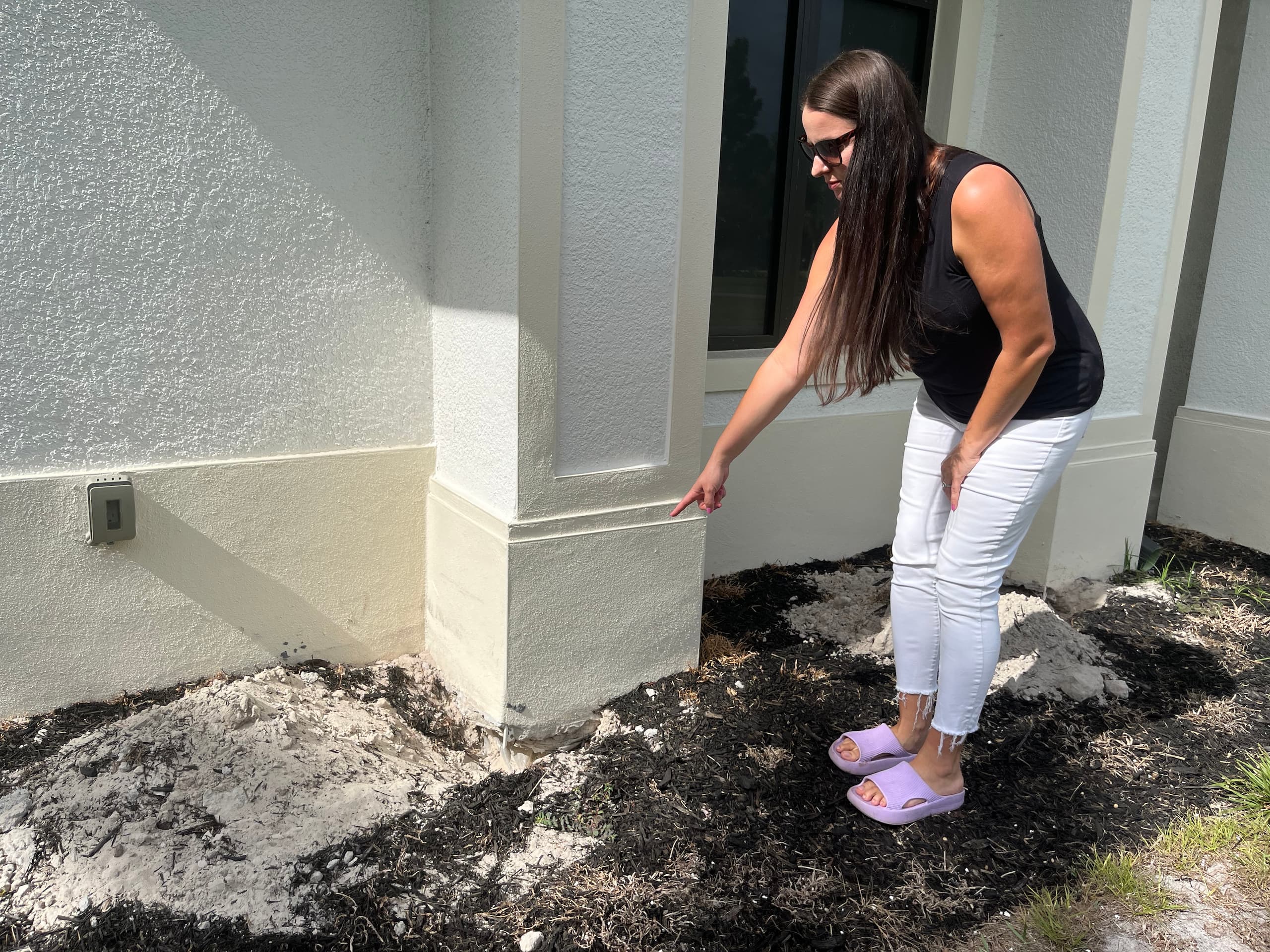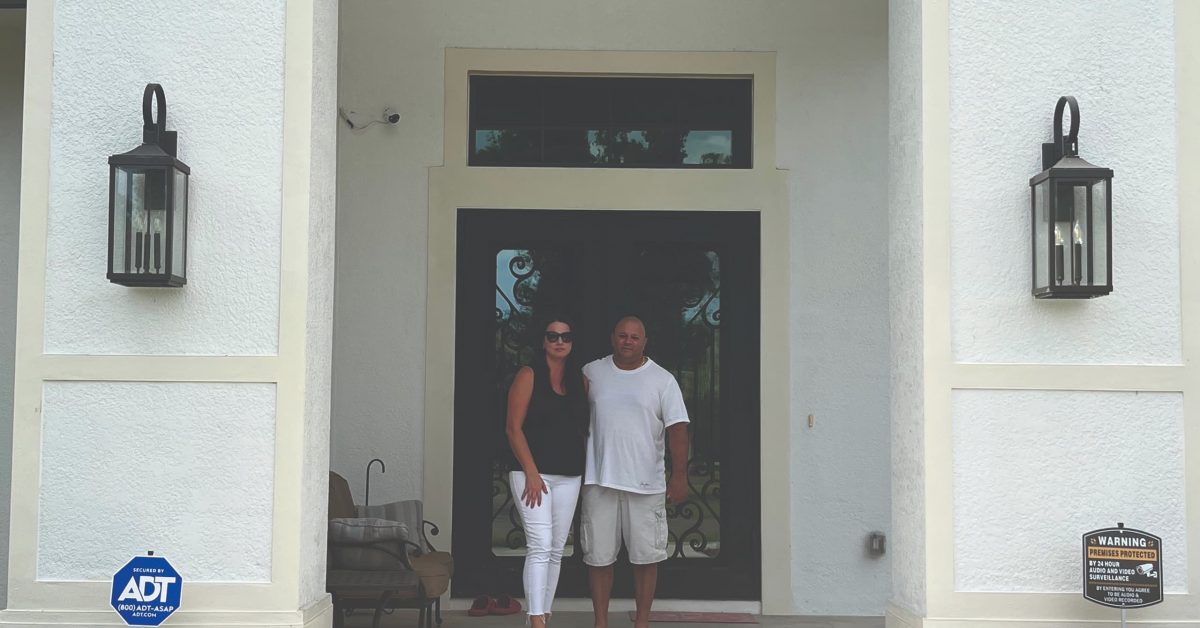Monika and Paul Gatto purchased 2½ acres off Livingston Road five years ago and signed a contract to build their dream home.
This month marks a year since Collier County revoked the North Naples home’s certificate of occupancy, finding it was issued in “error,” as the home had structural issues and didn’t comply with the Florida Building Code. It would take seven more months before city and county officials discovered rampant permit fraud that put into question the safety and structural integrity of the Gattos’ home and hundreds of others.
“It was supposed to be our forever dream home, but instead we got a nightmare,” Monika Gatto said of her contractor, Nova Homes of South Florida, whose countywide permit-pulling privileges were revoked this year. “I don’t know how they sleep at night. It’s just not right.”
Records show outside footings, which distribute the weight of a building evenly – preventing uneven settling or sinking — are missing. One side of the 5,472-square-foot home on Livingston Woods Lane extends four inches over the slab. A kitchen beam supporting the second floor is four feet too short and as a result, a column was built in the wrong location without a proper footing. That footing was installed four feet away, where the original column should be.
The lanai’s off-set tie beam – used to provide stability and prevent columns from buckling or leaning – is made of plywood, not reinforced concrete. And large custom windows Monika Gatto ordered for her home office, family room and loft are 14-16 inches smaller – not what the couple paid for.
In revoking the CO, Chief Building Official Fred Clum said two engineers’ reports showed the home didn’t match approved construction plans and Nova Homes never submitted revisions for six structural changes.
Five of the six structural problems were listed in the Gattos’ engineer’s report by JW Building Consultant Services, which is owned by the county’s former chief building official, Jonathan Walsh. Cronin Engineering, which was hired by Nova Homes, listed a sixth, that the builder failed to submit a revision for a cut or damaged bottom chord of the roof truss, which supports the truss and ceiling load.
CLB finding: misconduct
During a hearing in October, the Contractors Licensing Board gave licensed contractor Maharai Dacosta, who does business as Nova Homes, 60 days to fix the problems or permit-pulling privileges would be revoked.
The CLB cited the “substantial evidence” and the “gravity” of the violations, finding Dacosta and Nova Homes acted “willfully,” and never submitted revisions to show they’d altered plans – “misconduct” that was “grounds for discipline.” Nova Homes founder Frank Arcia, who supervised the construction, admitted he knew changes didn’t match the plans.
“Even if the county inspects and passes an inspection, that does not authorize a contractor to violate the code,” Deputy Building Official Doug Sposito told the CLB. “We didn’t see it. For whatever reasons, we didn’t catch these things.
“… This was a unique situation in that we were made aware of information substantially after a CO was issued, that had we been given that information prior to the CO, we never would have issued the CO,” he said of six violations.
Part of the exterior concrete masonry wall “was hanging over the edge of the footing by more than what we consider tolerable,” he said, and “half or more of the wall was not being supported,” while a corner of the home wasn’t supported by a concrete footing.
“Withdraw the dirt, show us the footing is there properly, and we’re good. We’ll push the dirt back and everything’s fine,” Sposito said.
He told the CLB not to focus on quality of workmanship, but the necessity of keeping accurate records to ensure they match approved plans. “The quality of the work would be a civil matter between them,” he said of the Gattos and Nova Homes.
CLB Chair Stephen Jaron, a custom home builder, noted the structural concrete inspections failed several times and called the offset tie-beam a “pretty big” error.
“There are a lot of errors there, but to me, it’s pretty glaring,” Jaron said. “… The homeowner is kind of stuck in the middle of a house that might fall down.”
And that’s what the Gattos fear.
Homes affected countywide
The couple are among hundreds of residents countywide whose homes were built or renovated based on approved plans that contained a fraudulent architectural seal belonging to 91-year-old Gene Cravillion. He suffers from dementia, hasn’t practiced since August 2022 and lives in a North Naples memory care facility.
The Gattos’ plans initially were stamped in March 2021 by Leonard LaForest, an architect who was suspended in 2019 and died in November 2021. The Gattos’ home designer, Dave Wainscott of Naples, was later disciplined for using LaForest’s seal after his death. It’s uncertain whether LaForest actually signed the Gattos’ plans.
The digital seal stamped on plans is used to verify a state-registered architect’s identity, that architectural documents are authentic and comply with local, state and federal standards that ensure safety and structural integrity.
Records indicate the majority of plans countywide involve Wainscott. In November 2023, he paid a $24,000 fine to the state Board of Architecture and Interior Design for using LaForest’s seal.
State Department of Business & Professional Regulation records show Wainscott has a history of unlicensed activity spanning more than three decades, including identifying himself as an architect or engineer, as he did at the Gattos’ home. Letters show Wainscott told county officials Cravillion was present when he visited the Gattos’ home during structural X-ray scans in October.
During the CLB hearing, Arcia, the Nova Homes founder, told the CLB that Cravillion was there to answer questions — although he was in memory care more than 10 miles away. And several letters purportedly written by Cravillion to county officials used the address of ASSA, a permitting and planning company where Cravillion once worked.
Since January, when the continued use of his seal was first discovered by a Marco Island permit clerk, stop-work orders halted construction countywide and homeowners and numerous builders were ordered to hire a new architect or engineer. Nova Homes severed ties with Wainscott, contending it was a victim and is working to resolve all permit concerns “as expeditiously as possible.”
Wainscott and ASSA are among 25 designers, builders and others who received cease-and-desist letters in January from the state DBPR in an investigation headed by the state board’s investigator, Melissa Minacci. If they’re not cleared, they face a probable-cause hearing before the board in July. Local law enforcement agencies provided evidence to Minacci, and the FBI is investigating.
Wainscott has sued ASSA CEO Octavio Sarmiento, alleging he jeopardized projects, and caused nearly $106,000 in losses and damage to Wainscott’s reputation. Wainscott had contracted with ASSA for architectural services. ASSA denies any wrongdoing.

Escalating costs, structural problems
State law says an architect must be involved in a project from start to finish and can’t just stamp finished plans. A licensed architect isn’t required for single-family homes, just for structural components, such as trusses and roofs, and to certify wind-code compliance.
Without an architect monitoring work to ensure it adhered to approved plans, the Gattos’ home has glaring structural problems. Each month, they’re issued a temporary CO as they wait for Nova Homes to fix six conditions that engineers’ reports – and more recent ground-penetrating radar concrete X-rays – show don’t match approved plans.
They spent their life savings, $415,000 for the land and $852,817 for the custom-home contract, mostly covered by the sale of their prior home. Costs escalated due to change orders and litigation. Nova Homes’ contracts require buyers to go through binding arbitration, a process that often favors builders – and ensures prospective buyers can’t vet builders or know about lawsuits.
“They’re trying to bankrupt us, and it’s working,” Paul Gatto said. “To repair it costs a lot of money.”
In May 2024, the arbitrator ordered the couple to pay Nova Homes $82,014.24, including $42,140.85 – the last payment they’d withheld due to structural problems – and Nova Homes’ legal fees. That’s on top of their attorney fees.
The next month, the CO was revoked, prompting the Gattos to appeal the ruling.
This January, Collier Circuit Judge Ramiro Mañalich overturned it, citing the revoked CO. Nova Homes then appealed to the state District Court of Appeal, contending the Gattos had a “mere disagreement” with the arbitrator’s decision and were “trying to obtain a different result.” The appeal is pending.
The anxiety, uncertainty and worry has caused health problems for Monika Gatto, who is seeking help on GoFundMe (bit.ly/gattogofundme).
“This situation has severely impacted my health, as I have heart issues and have started fainting from stress,” she wrote. “I work two jobs, but with three children, it is extremely difficult to be in this situation. My husband and I had to stop our children’s activities, and we had to change our youngest daughter’s school because we could not afford the tuition due to the legal fees.
“We are living under extreme pressure without any resolution in sight. The funds raised will be used to cover extensive engineering and legal fees, revise plans with licensed and certified engineers and fix the home,” she wrote, adding they hope to assist other victims of the permit fraud.
Battling experts
Nova Homes later hired Pompano Beach-based X-Ray Concrete Inc. to conduct ground-penetrating radar X-rays in October to prove the home was structurally sound. Not trusting that report, the Gattos hired Horizon Construction Technologies of Bonita Springs, whose X-ray scans contradicted some of Nova Homes’ findings and revealed more problems.
Because two fraudulent seals were used to stamp the Gattos’ plans, there are questions about structural integrity.
“The seal indicates that to the best of the architect’s knowledge, those plans meet the current and applicable building code,” Maitland architect John Ehrig, who served on the state board from 2008 to last October, told The Naples Press. “… It’s [the county building department’s] responsibility to review the plans in accordance with the Florida Building Code to see that they are code compliant.”
At the worst, he said, fraudulently using another architect’s seal “could be a danger.
“That’s one of the reasons the Legislature has licensed architects and engineers. We protect the health, safety and welfare,” he added.
Although the Gattos’ home appears luxurious and beautiful, closer inspection reveals obvious structural issues. And there are cosmetic problems, such as cracks on walls and ceilings, scratched windows, chipped tiles – many missing grouts that aren’t glued down – and some doors aren’t the higher-quality ones they ordered.
The Gattos repeatedly asked Nova Homes for extra boxes of the wood-look tiles, but they never got them and weren’t charged. They were discontinued tiles and aren’t available. Nova Homes replaced one, but the color doesn’t match.
Nova Homes addressed the smaller windows by submitting a plan revision, never alerting the Gattos. Collier County approved it.
“It is not ethical to do the changes without notifying the owner,” said renowned Naples architect Matthew Kragh, founder of MHK Architecture.
Monika Gatto says she would have caught some problems, including the longer kitchen wall that went against their open-concept design and caused a shorter support beam. But their contract didn’t allow them to visit the construction site or bring their own expert during a final walk-through.
“They would not allow any inspection with a licensed professional until the CO was issued and all money was paid,” she said, calling that ridiculous.
Kragh called both circumstances “very unusual.
“Our clients visit the site during construction under the supervision of the contractor all the time,” he said.
“Typically, the architect does construction administration services to make sure the project is being built per the plans and will send field reports to the owner to let them know of any issues,” Kragh said, adding, however, that it depends on the contract.
When he was president of the American Institute of Architects of Florida Southwest decades ago, Kragh said he knew some of the 25 people involved in this case and they were “bad players.”
“It drove the legitimate architects who were members of the AIA absolutely insane,” he said. “This type of activity dilutes the practice and also creates serious health, safety and welfare concerns to the public.”
This story was published in The Naples Press on June 13.





